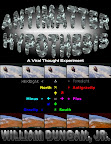Here are a number of stars caught in the act of ejecting material. These celestial objects are called ‘planetary nebulae,’ a misleading term coined by early astronomers. Planets form at the beginning of a star’s life not near the end, like this. The Hubble Space Telescope used color filters to identify the spectra of different elements in these images.
| red | nitrogen |
| green | hydrogen |
| blue | oxygen |
This composite image of planetary nebulae show sun-like stars in old age. The energy released by fusion exerts outward pressure away from the core of a star, counteracting the pull of gravity. When that fusion stops, the star collapses, ejects material, and becomes a white dwarf, with a sun range mass and an Earth range volume. White dwarfs radiate heat until they cool and then become black dwarfs. Stars the size of the sun only produce elements up to oxygen or thereabouts, which appear in the spectra of the ejecta. And the ejecta take on fancy shapes that are diagrammed in these illustrations from the HubbleSite. With a planetary disk around these stars, like the Hubble 5 image, jets are produced in opposite directions.
| red | nitrogen |
| green | hydrogen |
| blue | oxygen |
| violet | helium |
The spectral emission lines of atomic elements and molecules are like fingerprints that allow astronomers to ‘ID’ the perpetrators of celestial electromagnetic radiation. The full range of the electromagnetic spectrum is shown here. Our eyes can only detect the visible part, but through technology cameras and telescopes can record what remains invisible to our eyes.
| Electromagnetic Spectrum | ||||||
| Radio | Microwave | Infrared | Visible | Ultraviolet | X-ray | Gamma ray |









No comments:
Post a Comment